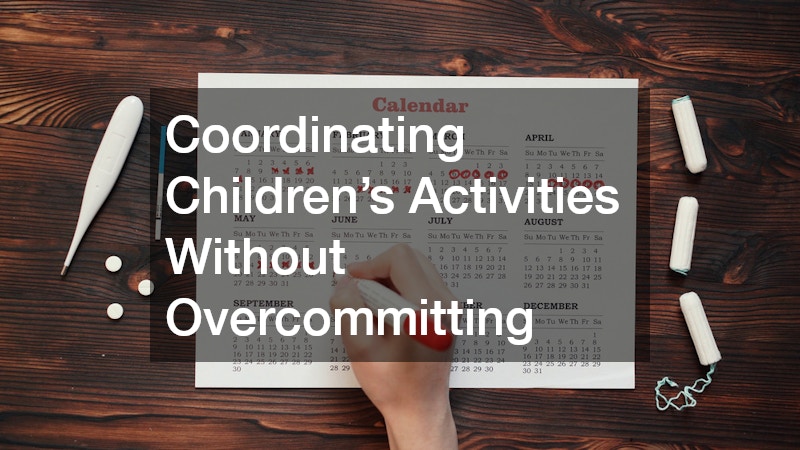Modern family life can feel like an ongoing juggling act. Between work responsibilities, school drop-offs, extracurricular activities, and endless household tasks, parents often find themselves racing from one obligation to the next. The constant need to manage multiple schedules can easily lead to burnout — but with effective organization, those chaotic days can turn into a calm, coordinated routine.
Parent organizing goes beyond simply writing events on a calendar. It’s about developing systems that make daily life smoother, fostering communication among family members, and creating an environment that supports balance. By setting clear expectations and building consistency, parents can reclaim their time and bring order to their homes.
This guide explores practical, research-based methods to streamline your family’s schedule. Whether you’re managing toddlers or teenagers, these strategies can reduce stress, improve efficiency, and leave more room for meaningful moments together. From health appointments to family fun, parent organizing can transform how your household operates — making every day run more efficiently and with less frustration.
Creating a Centralized Family Calendar
A well-maintained calendar is the cornerstone of successful parent organizing. Families that rely on scattered reminders, sticky notes, or last-minute texts often find themselves overwhelmed and disorganized. Centralizing every event, appointment, and commitment in one place creates clarity and prevents conflicts.
Digital calendars like Google Calendar or Cozi are excellent tools for families. Parents can color-code each person’s schedule and sync updates across devices, ensuring everyone is on the same page. For those who prefer tangible visuals, a large wall calendar placed in the kitchen or entryway can serve as the household command center. This system allows you to map out not just major events but small yet essential details. Setting reminders for recurring needs — such as haircut appointment or grocery restocks — ensures nothing slips through the cracks. Visualizing your week ahead helps parents plan meals, assign chores, and prepare transportation efficiently.
A digital calendar can even include notes, attachments, and links for important documents like permission slips or medical forms. Families can create categories for school, work, health, and social activities, making it easier to identify which areas may be overloaded. When used consistently, a shared calendar becomes a source of stability and collaboration. Children learn the importance of time management and responsibility, while parents can relax knowing everyone is informed. Over time, the process of updating and checking the calendar becomes second nature, serving as a foundation for calm, coordinated living.
Establishing Routines That Reduce Stress
Once the family calendar is in place, routines bring predictability to daily life. They provide structure that helps children feel secure and gives parents peace of mind. Routines also improve productivity, as less time is wasted deciding what to do next.
To develop an effective schedule, start by assessing your household’s natural flow. Identify key transition points — morning wake-ups, school prep, after-school time, and bedtime. For instance, establishing a consistent morning routine where everyone eats breakfast together and reviews the day’s plans can set a positive tone. Visual cues can also help. Younger children benefit from visual charts that show what comes next — brushing teeth, packing lunches, or putting on shoes. This reduces verbal reminders and encourages independence. Parents should also plan “buffer periods” in the schedule to handle unexpected slowdowns like missing homework or a misplaced jacket.
As children grow, routines must evolve. Participation in extracurriculars or after-care programs can shift evening dynamics. Parents may need to adjust dinner times or homework hours to fit these changes. By revisiting routines regularly, families stay flexible and avoid feeling locked into outdated patterns.
The key is balance: enough structure to ensure consistency, but enough flexibility to handle surprises gracefully. A steady rhythm doesn’t just make the household run smoothly — it builds resilience and emotional security. Children who grow up within consistent routines often develop stronger time management and problem-solving skills as adults.
Prioritizing Health and Wellness in the Family Schedule
Parent organizing isn’t only about logistics — it’s also about ensuring that physical and emotional health remain priorities. In the rush of daily life, many families overlook essential wellness routines, leading to stress and burnout. By embedding health-focused habits into your calendar, you create a sustainable system that supports everyone’s well-being.
Start by scheduling preventive appointments early. Annual checkups, dental cleanings, and vision exams should be booked months in advance. Marking reminders for family dentists ensures you never miss those twice-yearly cleanings. Scheduling similar appointments together — such as siblings visiting the same provider on one day — saves time and minimizes disruptions.
Parents should also coordinate meal planning around busy weeks. Prepping ingredients on weekends, freezing healthy dinners, or setting up quick breakfast options can keep nutrition consistent even during chaotic mornings. Beyond physical health, emotional well-being deserves equal attention. Set aside time for family check-ins, where everyone can share thoughts or concerns. Small gestures, like taking a walk together or reading before bed, help maintain a sense of connection.
It’s also important to plan specialist visits when needed. For example, scheduling regular checkups with an orthodontist for kids can prevent issues from escalating and make treatments more manageable. Consistent planning around health care keeps the family proactive instead of reactive, saving time and stress in the long run. Ultimately, a healthy household is a productive one. By integrating wellness into your routine, you’re not just managing time — you’re improving quality of life for everyone involved.
Coordinating Children’s Activities Without Overcommitting
Children’s schedules can quickly become the most complicated part of family management. Between sports practices, art lessons, and community clubs, parents often feel like full-time chauffeurs. Effective parent organizing means understanding the difference between being engaged and being overextended When evaluating activities, focus on your child’s genuine interests rather than external pressure to do everything. Too many commitments can lead to stress, fatigue, and even resentment. Instead, aim for a balanced approach — one physical activity, one creative outlet, and plenty of free time for rest and play.
Create a weekly visual schedule to keep everyone informed of practice times, performances, and special events. Parents can assign tasks like equipment prep or snack duty to children to encourage responsibility. Keeping a shared document with contacts, locations, and schedules also helps avoid last-minute confusion. Parents can also plan around community resources. Enrolling kids in nearby extracurriculars or after-care programs reduces travel time and builds local friendships. These programs often provide academic support or enrichment activities that complement home learning.
Remember to include downtime in every schedule. Children need unstructured hours to recharge and explore personal interests. Protect one evening each week as a “family reset” with no activities, where everyone reconnects without distractions. Balancing participation and rest ensures that your child remains enthusiastic about their activities. It also gives parents room to breathe — transforming what could be overwhelming logistics into an enjoyable rhythm of family engagement.
Streamlining Home Responsibilities Through Delegation
Running a household efficiently requires more than scheduling appointments — it demands teamwork. Parent organizing works best when every family member shares responsibility. Delegating chores not only lightens the parent’s workload but also instills a sense of accountability in children. Start by listing all recurring household tasks, from cleaning and laundry to grocery shopping and pet care. Then, assign roles based on age and capability. Even young children can help sort laundry, feed pets, or set the table. Teens can take on larger projects like vacuuming, organizing closets, or assisting with outdoor chores.
To ensure fairness, implement a rotating chore chart that changes weekly. This prevents resentment and teaches adaptability. Holding a brief family meeting each weekend to review progress can make the process feel collaborative rather than punitive. Technology can enhance household management. Smart home systems allow you to automate lighting, reminders, and temperature control, saving both time and energy. Apps like Todoist or Trello can organize task lists and track progress. Parents can also set up digital grocery lists that sync between devices for easy updates.
When larger or urgent issues arise, knowing when to outsource is key. Scheduling professional services like emergency drain cleaning can prevent household disruptions from escalating. Relying on experts when appropriate saves time and prevents unnecessary stress. Delegation empowers everyone in the family. It transforms chores into learning opportunities and frees up valuable time for rest, hobbies, or connection. When everyone contributes, home life feels balanced — and parents gain back precious mental space.
Managing Communication and Appointments Effectively
Good communication is at the heart of all successful parent organizing systems. Without it, even the best plans fall apart. Families that share information openly avoid misunderstandings, missed appointments, and unnecessary stress. Parents should establish consistent check-in times — perhaps every Sunday evening or weekday morning — to review upcoming events. These discussions can include everything from meal planning to transportation logistics. Encouraging children to participate teaches them to take ownership of their commitments.
Digital communication tools simplify coordination. Group messaging apps or family organization platforms make it easy to share updates instantly. Parents can set automated reminders for upcoming events like parent-teacher meetings, sports tournaments, or medical appointments. Documentation also helps prevent confusion. Keeping an organized digital file for appointment confirmations, receipts, and important forms ensures quick access when needed. For example, having a clear record of visits to the orthodontist for kids can streamline scheduling and insurance paperwork.
Consistency and visibility matter most. Displaying a physical calendar in a common area reinforces accountability and reduces the burden on one parent to track everything. Families should also agree on standard communication methods for changes — such as texting “update” when plans shift — so everyone stays aligned. Strong communication isn’t just logistical — it strengthens relationships. When everyone feels heard and informed, tension decreases, and teamwork flourishes. Clear planning makes the family operate more like a unit, ensuring that even unexpected events are handled with cooperation and confidence.
Staying Prepared for Unexpected Events
Even the most meticulous schedules can be disrupted by unforeseen circumstances. Illness, sudden weather shifts, or household emergencies can derail plans in seconds. Effective parent organizing includes building flexibility and preparedness into your routine.
Start by creating a family emergency plan. List key contacts, emergency routes, and essential supplies. Store this information in both printed and digital formats. Keeping backup essentials — flashlights, bottled water, and first-aid kits — ensures your family can respond quickly when needed.
Parents should also anticipate common disruptions and have contingency plans. For example, if a car breaks down, knowing who can assist with school pickups or work commutes reduces panic. Similarly, monitoring weather forecasting helps parents plan for road closures, storms, or outdoor cancellations ahead of time.
Financial preparedness also plays a role. Keeping an emergency fund for unexpected repairs or medical costs helps prevent financial strain during stressful periods. Insurance documents, warranties, and emergency service numbers should be organized and accessible.
Equally important is emotional preparedness. Teaching children how to respond calmly during unexpected events builds confidence. Discussing simple “what if” scenarios — like power outages or travel delays — turns anxiety into understanding. Preparedness doesn’t mean expecting a constant crisis; it means creating a safety net. When families have plans in place, small disruptions become manageable. Parents who embrace proactive planning are better equipped to maintain order, even when life throws curveballs their way.
Incorporating Fun and Quality Time Into Busy Schedules
While structure is vital, joy is what gives life meaning. Parent organizing should enhance family happiness — not suppress it. Scheduling fun and relaxation is as important as scheduling work and chores.
Set aside designated times for family recreation each week. These moments don’t have to be elaborate; a simple picnic, board game, or afternoon movie can strengthen bonds. When fun is planned intentionally, it becomes a protected part of the family routine rather than an afterthought.
Parents can explore creative community options to keep family life engaging. Attending a youth group or visiting a local birthday party venue adds variety and social connection. These experiences foster relationships beyond the household and teach children about teamwork and friendship. For households with small children, finding activities for young children that promote learning and fun is essential. Story hours at the library, music classes, or outdoor playgroups help build motor and social skills while giving parents a chance to connect with other families.
Small joys can even be woven into errands. A trip to pick up local prescription eyewear or groceries can turn into a quick lunch date or shared treat. Turning routine obligations into micro-moments of connection keeps family life lighthearted. Balancing fun and structure creates emotional stability. Families that play together communicate better, solve problems collaboratively, and maintain a positive outlook even during stressful times. In the end, these shared moments — not perfectly managed schedules — are what children remember most.
The art of parent organizing lies in combining structure with flexibility, discipline with empathy, and productivity with joy. By developing shared systems — calendars, routines, communication channels, and contingency plans — families can turn daily chaos into a steady rhythm of cooperation and care. When parents prioritize organization, health, and connection equally, they create a home environment where everyone thrives. The key isn’t perfection but intentionality. A thoughtfully structured schedule supports rather than controls, allowing more space for meaningful experiences and personal growth.
Each family is unique, so it’s important to tailor these methods to your household’s rhythm. Whether you’re booking your next haircut appointment, planning visits to family dentists, or navigating a week filled with extracurriculars, efficient parent organizing ensures nothing important is forgotten — including time for laughter and love. When parents lead with balance and awareness, they teach their children the value of time, communication, and adaptability. In doing so, they build not only an efficient household but a resilient and harmonious family that can handle whatever life brings next.







